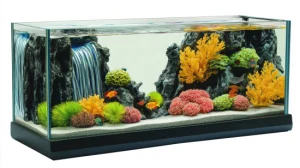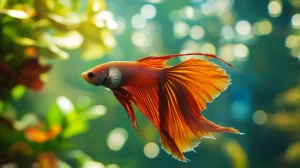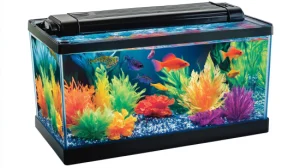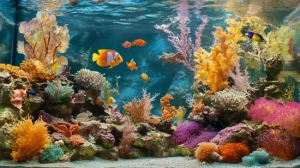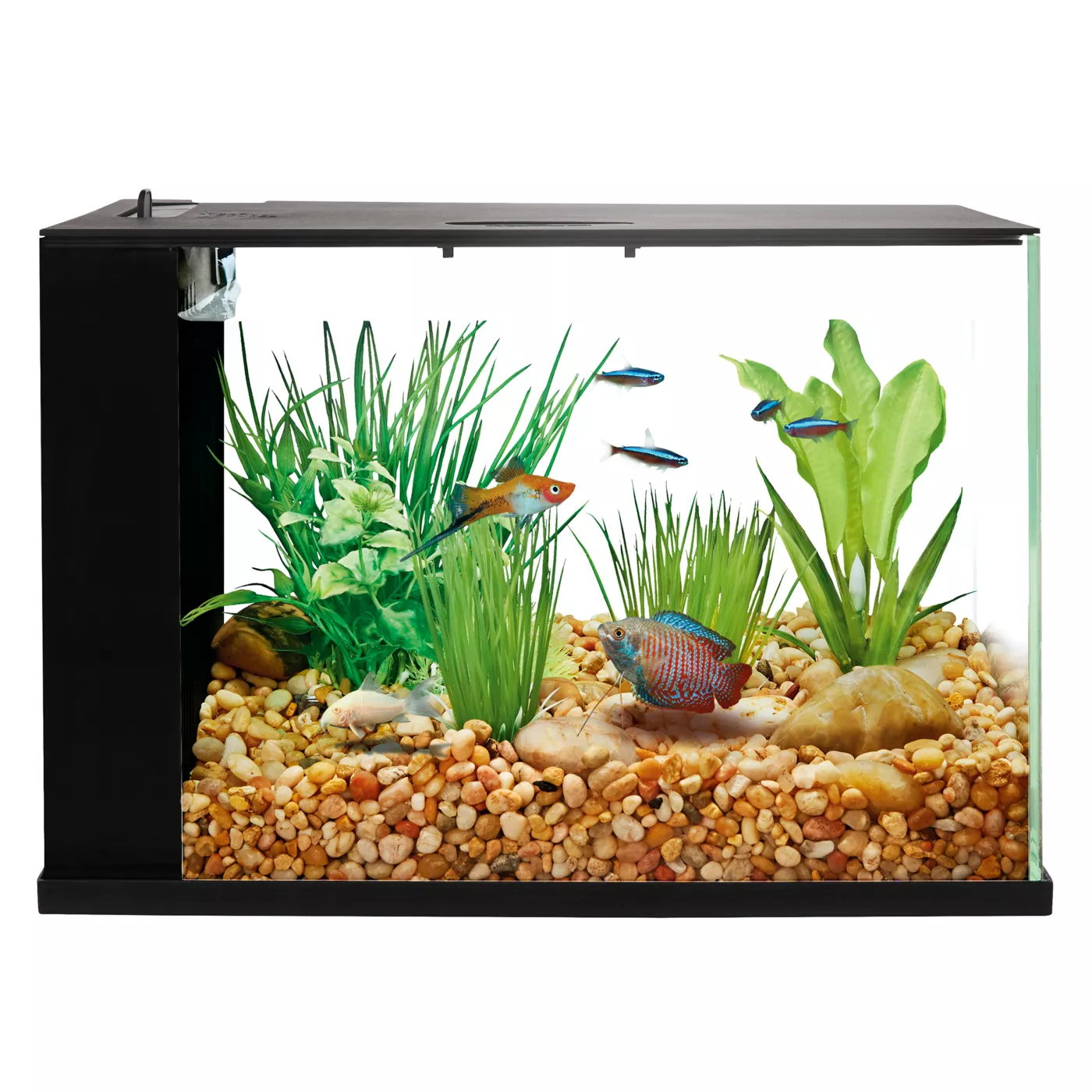
Top Fin® Easy Clean Aquarium – 3 Gallon
- 3-gallon tank with hood
- Lid with feeding door
- Integrated filtration system with pump
- Hydro-change technology
$44.99
Everything You Need to Know Before Getting a 3 Gallon Top Fin Aquarium
As an avid aquarist and fishkeeper, I understand the excitement of getting a new fish tank. The Top Fin 3 gallon aquarium is one of the most popular small tanks on the market, perfect for beginners and experienced hobbyists alike. Before you run out and buy one, it’s important to learn everything you can to set yourself up for success. In this comprehensive buying guide, I’ll share my tips and tricks for choosing, setting up, stocking, and maintaining a thriving 3 gallon Top Fin tank.
What are the dimensions of a Top Fin 3 Gallon Tank?
The Top Fin 3 has dimensions of 16 x 8 x 9.5 inches, giving it a generous 3 gallon capacity. The sleek rectangular shape makes it easy to place on most desks, cabinets, or tabletops. With a lightweight frame, it’s also quite portable if you want to move it between rooms. The modest size and small footprint make it an excellent choice for those with limited space.
How do you set up a Top Fin 3 Gallon Tank?
Setting up a new 3 gallon Top Fin aquarium takes a bit of planning but it’s fairly straightforward. Here are the step-by-step instructions:
- Thoroughly wash the tank, hood, and any decorations with water and a mild soap. Rinse away any soap residue.
- Add the substrate such as fine gravel or sand, creating a gentle slope from back to front. This allows more room up front for aquascaping.
- Install the filter and heater per manufacturer instructions, positioning them to maximize water flow and heat distribution.
- Fill the tank slowly with dechlorinated water, aiming for a temperature around 76-82°F depending on your stocking choices.
- Plant any live plants and decorate with hides, rocks, driftwood, etc.
- Install the hood and lighting, keeping intensity moderate for a small tank.
- Cycle the tank either fishlessly or with a few hardy fish. Test water parameters daily and do partial water changes as needed.
- Once cycled, add your fish stock slowly over several weeks. Observe inhabitants closely.
With a little planning and proper setup, your Top Fin 3 gallon will be up and running smoothly! Let those aquascaping ideas loose.
What fish are suitable for a Top Fin 3 Gallon Tank?
Many nano-sized fish and invertebrates are well-suited for life in a 3 gallon tank:
- Bettas – A single male or female betta is the classic choice. They’ll have plenty of swimming space and their long fins will flow beautifully.
- Guppies – You could keep 3-4 male guppies or just one male-female pair since they breed readily. Their colorful tails add flash.
- Tetras – A small school of 6-8 glowlight tetras or ember tetras work nicely and display schooling behavior.
- Endler’s Livebearers – A trio of male Endlers makes a very active and colorful tank. Beware, the females breed often.
- Dwarf Crayfish – One crayfish becoming the tank “centerpiece” has bold personality. Make sure it can’t escape!
- Snails – Nerites, mysteries and others serve clean up crew duties. They also add visual interest.
- Shrimp – Amanos, ghost or cherry shrimp bring constant motion. A group of 6-8 is recommended.
When stocking, remember less is more in a small tank. Avoidlarge or aggressive fish that need more swimming room.
How often should I clean a Top Fin 3 Gallon Tank?
On a weekly basis, a 3 gallon Top Fin aquarium will need partial water changes of 25-30% to maintain pristine water quality. Use a gravel vacuumto suck up debris from the substrate during water removal. Then refill slowly with dechlorinated, temperature matched water.
Every month, give the inside glass a scrub with an algae sponge or pad to prevent buildup. Wipe down the light hood if algae is accumulating. Check the filter monthly as well and rinse/replace media as directed in the manual. Deep clean the whole tank every 3-4 months, including thorough glass cleaning, substrate vacuuming and filter overhaul.
With small tanks, staying on top of maintenance is crucial! Even one week of neglect can throw off balances. Frequent partial water changes are the best medicine.
What filter is best for a Top Fin 3 Gallon Tank?
When selecting a filtration system for a Top Fin 3 gallon setup, you want gentle water flow but adequate filtering capacity. My top picks are:
- Sponge filters – Low flow, simple operation and provide abundant surface area for beneficial bacteria. You’ll need an air pump.
- Internal/box filters – Convenient all-in-one units designed for nano tanks. Easy to conceal while still offering adjustable flow.
- Small canister filters – More powerful and customizable filtration in a compact canister design. Perfect for heavily stocked/planted tanks. Requires more maintenance.
- Nano hang-on-back filters – Unintrusive and created specifically for tanks under 5 gallons. Leaves you more space inside the tank for aquascaping.
No matter what type of filtration you choose, supplement it with biological media to boost beneficial bacteria. And baffle the flow if needed to prevent too much water turbulence. A 3 gallon tank doesn’t need extreme filtering power.
How many fish can a Top Fin 3 Gallon Tank hold?
The general rule of thumb for fish stocking is 1 inch of full grown adult fish per 1 gallon of water. With a Top Fin 3 Gallon aquarium that limits you to around 3 inches of total fish.
Here are some appropriate options:
- 1 Betta (~2.5 inches)
- 1 Dwarf Gourami (~2 inches)
- 3 Neon Tetras (~1 inch each)
- 1 Sparkling Gourami + 3 Pygmy Corydoras (~1 inch + 1 inch)
- 1 Male Guppy + 2 Endler’s (~1.5 inch + 0.5 inch each)
The possibilities are nearly endless within the 3 inch stocking limit! To maximize fish health, start with less stock and only add more gradually over several weeks. This allows the nitrogen cycle to adjust and prevents an ammonia spike. A trio of nano fish is perfect in a planted 3 gallon tank.
What is the best substrate for a Top Fin 3 Gallon Tank?
With a smaller tank, substrate choice becomes especially important, as there is limited room for the bacterial colonies that reside in the substrate. Here are some excellent options:
- Fine sand allows easy cleaning by siphoning and provides a natural look. Pool filter sand is inexpensive. Play sand may alter pH.
- Gravel between 3-5mm diameter is a classic choice. Allow 1-1.5lbs per gallon. Rounded gravel prevents injury to bottom dwellers.
- Bare bottom tanks work well, making cleaning a breeze. Not the most natural looking, but suitable for species like bettas.
- Soil/dirt substrates can grow plants beautifully. However, they will require more maintenance in a nano tank to prevent fouling.
- Fluorite, Eco-Complete, and other commercial substrates provide nutrients for plant growth. But the smaller grain size makes vacuuming difficult.
Whatever you choose, provide 1-1.5 inches of substrate depth for your plants and burrowing species. Make sure it complements the tank inhabitants.
How to cycle a Top Fin 3 Gallon Tank?
Cycling establishes the all-important nitrogen cycle required for fish health. Here is a step-by-step guide to fishless cycling a 3 gallon Top Fin:
- After setup, add an ammonia source. Pure ammonia or fish food work well. Target 3-5ppm ammonia.
- Test levels daily and continue dosing ammonia to 3-5ppm, allowing bacteria colonies to grow.
- Once ammonia and nitrites reach zero within 24 hours of dosing, cycle is complete!
- Perform large 50% water changes for 3-4 days to reduce nitrates. Add Prime to detoxify any remaining ammonia or nitrite.
- On day 5, slowly begin adding your chosen livestock over several weeks. Keep testing water parameters.
- Once stocked, test weekly for nitrates. Useful bacteria have grown and tank is cycled!
Take your time, be patient and keep conditions stable. This method allows the nitrogen cycle to establish safely before any fish are risked.
Can you grow plants in a Top Fin 3 Gallon Tank?
Absolutely! A planted 3 gallon Top Fin tank can be stunning. Plants oxygenate the water, absorb nutrients, and provide security for shy fish. Some excellent plant choices include:
- Anubias or Java Fern attached to decor instead of planted in the substrate. They grow slowly and tolerate low light.
- Floating plants like dwarf Water Lettuce or Frogbit that uptake excess nutrients from the water column.
- Easy carpeting plants like Dwarf Sagittarius, Marsilea or Staurogyne repens. Their short stature won’t overtake a nano tank.
- Stem plants like Rotala rotundifolia, Ludwigia or Water Wisteria. Trim often to control height.
- Mosses like Java, Christmas, or Flame Moss attached to hardscape. They provide soft texture and hiding spots.
Use root tabs for heavy root feeders and dose a liquid fertlizer once a week. With a good light and nutrient levels, your plants will thrive!
What lighting is recommended for a Top Fin 3 Gallon Tank?
Proper aquarium lighting balances fish viewing, plant growth, and algae control. For a Top Fin 3 Gallon, aim for the following:
- Low to moderate intensity – 1-2 watts per gallon max for 6-8 hours daily. Avoid direct sunlight which causes algae.
- Full spectrum LED or fluorescent bulbs – These support plant growth better than standard LEDs. 6000-7500K color temperatures work well.
- Adjustable mount light – Goal is even coverage over tank length. Raise light to control intensity or algae growth as needed.
- Timer – Set a consistent photo period of 6-8 hours. Splitting the time into 2 blocks can allow a siesta period to limit algae.
- Optional dimmer – Dims intensity even more for fish comfort and planted tanks. Helpful for tanks with windows or room lighting.
With smaller tanks, start with lower intensity lighting and increase slowly if growth is limited. Observe plant and algae response and adjust accordingly.
How to maintain water quality in a Top Fin 3 Gallon Tank?
The keys to pristine water quality in a 3 gallon nano tank are:
- Weekly 25% partial water changes using a gravel vacuum to remove waste. Larger 50% changes if levels spike.
- Live plants to uptake excess nutrients like nitrate and phosphate that reduce water quality. Floaters are great at this!
- Adequate filtration with monthly maintenance to prevent debris accumulation that pollutes water.
- Test water parameters weekly. Quickly address any spikes in ammonia, nitrites, or high nitrates with water changes.
- Gravel vacuuming during each water change to get rid of decomposing organics before they increase nitrogenous waste.
- Dosing Prime or other dechlorinator with each water change and any time ammonia/nitrites are detected. Binds toxins.
- Cleaning filter media monthly in old tank water to remove gunk buildup. Don’t kill your beneficial bacteria!
- Reduced feeding amount and frequency. Only feed what fish can eat in 2 minutes, 1-2 times daily.
What are common issues with Top Fin 3 Gallon Tanks?
Some potential issues to be aware of with the Top Fin 3 Gallon kit include:
- Flimsy plastic rim – Prone to cracking or warping. Inspect rim for defects and reinforce with aquarium sealant if needed.
- Filter may be underpowered – Have a backup nano filter ready or use an air-powered sponge filter for better flow.
- Light hood hinges weaken over time – Check hinge screws often to ensure the light doesn’t crash down!
- Heater swing – Use a mini heater guard to prevent temperature fluctuations. Get an adjustable heater and set it ~2°F below desired temp.
- Lid warped or doesn’t sit flush – Can lead to fish jumping out! Check fit and use clips to secure if needed.
- No water test kit included – You’ll need to buy an API Freshwater Master kit for cycling and ongoing testing.
None are dealbreakers if addressed proactively. And the price is very wallet-friendly for starters!
How to install a heater in a Top Fin 3 Gallon Tank?
Maintaining proper water temperature is crucial for fish health. Here’s how to add a heater:
- Choose a 25-50 watt heater designed for nano tanks. Mini heaters from Hygger, Fluval, and Cobalt work great.
- Place horizontally either behind plants or near filter outflow for good water flow over heating element.
- Use suction cups to affix it above substrate level to prevent burning bottom dwellers.
- Initially set heater a few degrees below desired temp, then slowly increase over several hours while monitoring.
- For safety, use a heater guard to prevent direct contact with fish and delicate fins.
- Verify temps daily for consistency. Increase wattage if unable to maintain stable temperature.
With the right mini heater placement and guard, your fish will stay nice and toasty in their 3 gallon home!
What decorations are safe for a Top Fin 3 Gallon Tank?
When selecting decor for a small 3 gallon tank, safety for fish is the priority. Stay away from:
- Sharp decorations that can tear flowing fins – opt for smooth edges and openings larger than a dime.
- Loose decor that traps fish if dislodged – use sturdy mounted pieces or supervised free pieces.
- Toxic materials like painted resin, plastic plants, and treated wood. These can leach chemicals.
Instead choose:
- Live or silk plants and mosses. Provide security and enrich the tank.
- Smooth river rocks and rounded gravel substrate. Helps prevent scraped bellies.
- Ceramic, glass or natural stone decorations. Inert materials that altering pH or water chemistry.
- Driftwood, rocks, cave structures. Give fish places to explore and hide.
- Aquarium-safe resins and poly materials. Look for manufacturing specifically for aquarium use.
The possibilities are endless for nano tank decorations – have fun with it! Just be mindful of safety and tank size.
How to prevent algae in a Top Fin 3 Gallon Tank?
Algae prevention is all about balance in a little 3 gallon tank’s closed ecosystem. Here are my top tips:
- Provide consistent and ample plant growth to compete with algae for nutrients. Floaters are MVPs!
- Use a clean up crew – snails, shrimp and certain fish eat algae and detritus before it spreads.
- Reduce light intensity with a timer, dimmer, and raising light if needed. 6-7 hours max.
- Keep the tank away from direct sunlight which fuels algae growth.
- Maintain stable CO2 with good surface agitation, consistent temp and optimal plant mass. Fluctuations encourage algae.
- Test phosphates and nitrates weekly. Algae thrives on excess. Address with water changes and chemical export (plants or carbon).
- Wipe down glass manually and remove badly infested leaves. Don’t overclean – let the cleanup crew eat their share!
- Add Excel or specialty algaecide temporarily in excess growth situations, alongside above fixes.
Patience and persistence pays off. Balance the tank and algae struggles will subside.
How does a Top Fin 3 Gallon Tank compare to other tanks?
The Top Fin 3 Gallon starter kit hits a sweet spot of size, function, and affordability. Here’s how it stacks up:
- Price – One of the most budget-friendly complete kits at around $35. Comparable kits often run $50+.
- Quality – On the lower end but extremely adequate. Similar level to Tetra 3 gallons. Not as premium as Fluval or ADA.
- Filtration – Comes with a compact internal power filter. More versatile than Marineland Eclipse but less customizable than buying separate filter.
- Lighting – Standard LED with hinged plastic hood. Nice that it’s included but light is entry-level.
- Size – Perfect desktop nano tank at 3 gallon capacity. Rimless tanks offer more volume but no lid.
- Beginner-Friendliness – Everything you need is included for easy setup. Directions are straightforward but not as robust as Fluval or Eheim manuals.
For those starting out or wanting an extra small tank for their desk, the Top Fin 3 Gallon kit is hard to beat in terms of value and functionality. More advanced hobbyists will want rimsless or higher end tanks with customizable filter and lighting systems. But as far as beginner kits go, Top Fin hits all the marks!
Can a betta fish live in a Top Fin 3 Gallon Tank?
The Top Fin 3 Gallon is a fantastic option for betta fish! Here are some tips for betta success in this tank:
- Leave ample surface area free of equipment for easy access to breathe air. Bettas have labyrinth organs.
- Add floating plants like dwarf water lettuce for resting spots near the surface. Indian almond leaves release beneficial tannins too.
- Use a sponge filter or baffle the outflow from other filters. Bettas dislike strong currents from their long, flowing fins.
- Maintain warm water between 78-80°F. Bettas thrive in tropical temperatures. The 3 gallon volume is easy to heat.
- Offer plenty of hiding spots like caves and dense planting. Male bettas occasionally need a break from their own reflection!
- Select tankmates like snails, shrimp or a few small tetras that won’t nip flowing betta fins or stress your betta.
With some simple tweaks, a betta will live like a king in the Top Fin 3 Gallon tank! Their beauty and personality will really shine.
How to perform a water change in a Top Fin 3 Gallon Tank?
Here is a step-by-step guide for properly changing the water in a Top Fin 3 gallon tank:
- Use a gravel vacuum to remove 25-30% of the water, targeting waste buildup in the substrate.
- Discard the old tank water. Rinse any debris from the gravel tube exterior.
- Fill suitable container with new water. Use dechlorinator and heater to match tank temperature.
- Slowly add new water over a dish or decoration to avoid disturbing substrate. Pouring near the filter provides circulation.
- Use a thermometer to verify the temperature holds steady and no fluctuations were introduced.
- Use water test strips to check parameters like pH or ammonia weren’t altered. Address if needed.
- Wipe down equipment with an algae sponge as needed, like the filter intake or heater exterior.
- Check filter media and mechanics during cleaning. Rinse media monthly in old tank water only if very dirty.
- Sit back and observe fish eagerly exploring the cleaner tank! Continued routine water changes promote healthy fish and crystal clear water.
What is the price range for a Top Fin 3 Gallon Tank?
The standard Top Fin 3 Gallon Starter Kit retails around $35 at major chain stores. That includes the tank, hood, LED light, internal power filter, and setup guide.
The tank alone generally runs $15-20 depending on if it’s purchased separately during pet store sales and clearances.
Replacement parts like the filter and LED light hood will cost $10-15 each.
So for the entire setup, expect an investment of $35-50 depending on options. That makes it one of the most affordable complete 3 gallon kits on the market! With a bit of supplemental equipment like a heater and plants, you’ll have an aquarium ready to be fully stocked.
Where can I buy a Top Fin 3 Gallon Tank?
The Top Fin brand is exclusive to PetSmart. The 3 Gallon Rectangular Aquarium Starter Kit can be purchased both:
- In PetSmart stores – Sold in their aquarium section. Price match is available.
- Online at www.petsmart.com – Qualifies for free shipping or in-store pickup. Sign up for recurring delivery of filters and other supplies.
Check sales and clearance for special deals on standalone tanks or kits. Be sure to inspect the tank thoroughly for any cracks or warping before purchase.
The 3 gallon Top Fin kit has everything a beginner needs to get started with a small, desktop nano tank. Take the time to set it up properly and you’ll have a Slice of aquatic Zen in your home or office. Enjoy swimming with your new fishy friends!

